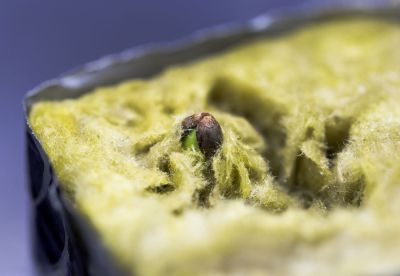Advantages and Disadvantages of Growing in Rockwool
Safety: Formed from natural materials, rockwool contains no harmful chemicals. It’s safe to use as a rooting medium and substrate material for plants. On the other hand, human exposure to rockwool represents a health issue. Due to its physical properties, rockwool growing medium can cause irritation to skin, eyes and lungs. Sterile: Since rockwool for plants is a manufactured product, it’s contains no weed seeds, disease pathogens or pests. This also means it contains no nutrients, organic compounds or microbes. Plants growing in rockwool require a balanced and complete hydroponic solution to meet their nutritional needs. Water Retention: Due its physical structure, rockwool drains excess water quickly. Yet, it retains small amounts of water near the bottom of the cube. This unique property allows plants to attain adequate hydration while allowing more air to circulate and oxygenate the roots. This difference in moisture levels from the top to the bottom of the cube makes rockwool ideal for hydroponics, but it can also make it difficult to determine when to irrigate the plants. This can result in over-watering. Reusable: As a rock derivative, rockwool doesn’t break down or erode over time, thus, it can be reused many times. Boiling or steaming between uses is recommended to kill pathogens. Being non-biodegradable also means it will last forever in a landfill, making rockwool for plants a not-so environmentally friendly product.
How to Plant in Rockwool
Follow these easy instructions when using rockwool growing medium cubes or blocks:
Preparation: Rockwool has a naturally high pH of 7 to 8. Prepare a solution of slightly acidic water (pH 5.5 to 6.5) by adding several drops of lemon juice using pH test strips to attain the correct acidity. Soak the rockwool cubes in this solution for about an hour.
Sowing Seed: Place two or three seeds in the hole at the top of the rockwool growing medium. Water using a hydroponic nutrient solution. When the plants are 2 to 3 inches (5 to 7.6 cm.) tall, they can be transplanted into soil or placed in a hydroponic garden.
Stem Cuttings: The night before taking the stem cutting, water the mother plant thoroughly. In the morning, remove a 4 inch (10 cm.) cutting from the mother plant. Dip the cut end of the stem in honey or rooting hormone. Place the cutting in the rockwool. Water using hydroponic nutrient solution.
Rockwool is the substrate of choice for many large hydroponic farms. But this clean, pathogen-free product is also readily available in smaller-sized packages specifically marketed for home gardeners. Whether you’re dabbling with cultivating lettuce in a hydroponic jar or you’re setting up a larger system, growing in rockwool gives your plants the advantage of superior root zone technology.
